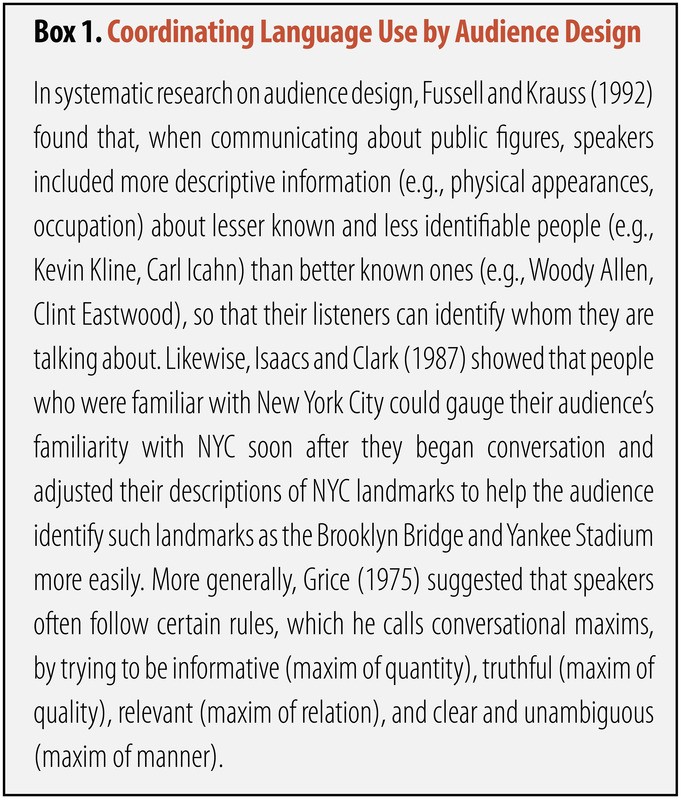How Do We Use Language?
If language is so ubiquitous, how do we actually use it? To be sure, some of us use it to write diaries and poetry, but the primary form of language use is interpersonal. That’s how we learn language, and that’s how we use it. Just like Adam and Ben, we exchange words and utterances to communicate with each other. Let’s consider the simplest case of two people, Adam and Ben, talking with each other. According to Clark (1996), in order for them to carry out a conversation, they must keep track of common ground. Common ground is a set of knowledge that the speaker and listener share and they think, assume, or otherwise take for granted that they share. So, when Adam says, “Gary bought a ring,” he takes for granted that Ben knows the meaning of the words he is using, whom Gary is, and what buying a ring means. When Ben says, “For Mary, isn’t it?” he takes for granted that Adam knows the meaning of these words, who Mary is, and what buying a ring for someone means. All these are part of their common ground.

The “common ground” in a conversation helps people coordinate their language use. And as conversations progress common ground shifts and changes as the participants add new information and cooperate to help one another understand. [Image: Converse College, https://goo.gl/UhbMQH, CC BY-NC 2.0, https://goo.gl/VnKlK8]
Note that, when Adam presents the information about Gary’s purchase of a ring, Ben responds by presenting his inference about who the recipient of the ring might be, namely, Mary. In conversational terms, Ben’s utterance acts as evidence for his comprehension of Adam’s utterance— “Yes, I understood that Gary bought a ring”—and Adam’s nod acts as evidence that he now has understood what Ben has said too —“Yes, I understood that you understood that Gary has bought a ring for Mary.” This new information is now added to the initial common ground. Thus, the pair of utterances by Adam and Ben (called an adjacency pair) together with Adam’s affirmative nod jointly completes one proposition, “Gary bought a ring for Mary,” and adds this information to their common ground. This way, common ground changes as we talk, gathering new information that we agree on and have evidence that we share. It evolves as people take turns to assume the roles of speaker and listener, and actively engage in the exchange of meaning.
Common ground helps people coordinate their language use. For instance, when a speaker says something to a listener, he or she takes into account their common ground, that is, what the speaker thinks the listener knows. Adam said what he did because he knew Ben would know who Gary was. He’d have said, “A friend of mine is getting married,” to another colleague who wouldn’t know Gary. This is called audience design (Fussell & Krauss, 1992); speakers design their utterances for their audiences by taking into account the audiences’ knowledge. If their audiences are seen to be knowledgeable about an object (such as Ben about Gary), they tend to use a brief label of the object (i.e., Gary); for a less knowledgeable audience, they use more descriptive words (e.g., “a friend of mine”) to help the audience understand their utterances (Box 1).

So, language use is a cooperative activity, but how do we coordinate our language use in a conversational setting? To be sure, we have a conversation in small groups. The number of people engaging in a conversation at a time is rarely more than four. By some counts (e.g., Dunbar, Duncan, & Nettle, 1995; James, 1953), more than 90 percent of conversations happen in a group of four individuals or less. Certainly, coordinating conversation among four is not as difficult as coordinating conversation among 10. But, even among only four people, if you think about it, everyday conversation is an almost miraculous achievement. We typically have a conversation by rapidly exchanging words and utterances in real time in a noisy environment. Think about your conversation at home in the morning, at a bus stop, in a shopping mall. How can we keep track of our common ground under such circumstances?
Pickering and Garrod (2004) argue that we achieve our conversational coordination by virtue of our ability to interactively align each other’s actions at different levels of language use: lexicon (i.e., words and expressions), syntax (i.e., grammatical rules for arranging words and expressions together), as well as speech rate and accent. For instance, when one person uses a certain expression to refer to an object in a conversation, others tend to use the same expression (e.g., Clark & Wilkes-Gibbs, 1986). Furthermore, if someone says “the cowboy offered a banana to the robber,” rather than “the cowboy offered the robber a banana,” others are more likely to use the same syntactic structure (e.g., “the girl gave a book to the boy” rather than “the girl gave the boy a book”) even if different words are involved (Branigan, Pickering, & Cleland, 2000). Finally, people in conversation tend to exhibit similar accents and rates of speech, and they are often associated with people’s social identity (Giles, Coupland, & Coupland, 1991). So, if you have lived in different places where people have somewhat different accents (e.g., United States and United Kingdom), you might have noticed that you speak with Americans with an American accent, but speak with Britons with a British accent.
Pickering and Garrod (2004) suggest that these interpersonal alignments at different levels of language use can activate similar situation models in the minds of those who are engaged in a conversation. Situation models are representations about the topic of a conversation. So, if you are talking about Gary and Mary with your friends, you might have a situation model of Gary giving Mary a ring in your mind. Pickering and Garrod’s theory is that as you describe this situation using language, others in the conversation begin to use similar words and grammar, and many other aspects of language use converge. As you all do so, similar situation models begin to be built in everyone’s mind through the mechanism known as priming. Priming occurs when your thinking about one concept (e.g., “ring”) reminds you about other related concepts (e.g., “marriage”, “wedding ceremony”). So, if everyone in the conversation knows about Gary, Mary, and the usual course of events associated with a ring—engagement, wedding, marriage, etc.— everyone is likely to construct a shared situation model about Gary and Mary.
Thus, making use of our highly developed interpersonal ability to imitate (i.e., executing the same action as another person) and cognitive ability to infer (i.e., one idea leading to other ideas), we humans coordinate our common ground, share situation models, and communicate with each other.

